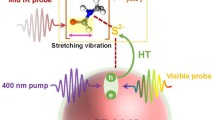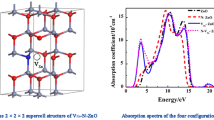Abstract
ZnO together with TiO2 is a main photocatalyst for various redox reactions to convert light energy into a chemical one and to purify the environment. Intrinsic surface defects in ZnO—the vacancies in anionic and cationic sublattices (F-type and V-type centers)—allow creation of long-lived (up to 103 s) photocatalysis centers and, therefore, tenfold increase in quantum yield of reactions. Slow surface states—the photocatalysis centers—appear via diffusion of electrons and holes generated during the interband transitions in the bulk of a photoactivated sample. The transfer efficiency, however, decreases sharply because of recombination of charge carriers and losses during overcoming the surface Schottky barrier. Neutral energy carriers—excitons—were used in this work to decrease these losses during the energy transfer to a surface. High exciton binding energy in ZnO (60 meV) allows it to move at room temperature without decay. The exciton energy loss for radiation is effectively decreased in our experiments via formation of a 2D surface structure. The results confirm high efficiency of exciton channel to form surface long-lived photocatalysis F-centers and V‑centers during the photoadsorption and photodesorption processes of oxygen, which simulate full cycle of a redox photocatalytic reaction.





Similar content being viewed by others
REFERENCES
Ü. Özgür, Ya. I. Alivov, C. Liu, A. Teke, and M. A. Re-shchikov, J. Appl. Phys. 98, 041301 (2005).
J. R. Sanchez-Valencia, M. Alcaire, P. Romero-Gómez, A. R. Gonzalez-Elipe, and A. Barranco, J. Phys. Chem. C 118, 9852 (2014).
C. Jagadish and S. Pearton, Zinc Oxide: Bulk, Thin Films and Nanostructures (Elsevier, Amsterdam, 2006).
C. Klingshirn, J. Fallert, H. Zhou, J. Sartor, C. Thiele, F. Maier-Flaig, D. Schneider, and H. Kalt, Phys. Status Solidi B 247, 1424 (2010).
N. H. Nickel and E. Terukov, Zinc Oxide—A Material for Micro- and Optoelectronic Applications (Springer, Berlin, 2005).
V. V. Titov, A. A. Lisachenko, I. Kh. Akopyan, M. E. Labzowskaya, and B. V. Novikov, J. Lumin. 195, 153 (2018).
I. V. Blashkov, L. L. Basov, and A. A. Lisachenko, J. Phys. Chem. C 121, 28364 (2017).
A. A. Lisachenko, J. Photochem. Photobiology A 354, 47 (2018).
I. Kh. Akopyan, M. E. Labzovskaya, A. A. Lisachenko, B. V. Novikov, A. Yu. Serov, V. V. Titov, N. G. Filosofov, Phys. Solid State 58, No. 9, 1767 (2016).
A. A. Lisachenko, Phys. B: Condens. Matter 404, 4842 (2009).
A. A. Lisachenko, Phys. Low-Dim. Struct., Nos. 7–8, 1 (2000).
V. E. Drozd, V. V. Titov, I. A. Kasatkin, L. L. Basov, A. A. Lisachenko, O. L. Stroyuk, and S. Y. Kuchmiy, Thin Solid Films 573, 128 (2014).
A. A. Lisachenko, J. Photochem. Photobiol. A 196, 127 (2008).
Y. Wang, B. Yang, N. Can, and P. D. Tounsend, J. Appl. Phys. 109, 053508 (2011).
P. A. Rodnyi, K. A. Chernenko, A. Zolotarjovs, L. Grigorjeva, E. I. Gorokhova, and I. D. Venevtsev, Phys. Solid State 58, 2055 (2016).
U. Pal, R. Melendrez, V. Chernov, and M. Barboza-Flores, Appl. Phys. Lett. 89, 183118 (2006).
ACKNOWLEDGMENTS
The authors are grateful to the staff of St. Petersburg State University Resource Centers: “Nanocomposites,” “Physical Methods of Surface Research,” “X-ray Diffraction Studies,” and “Nanophotonics.”
Funding
This work was financially supported by the Russian Foundation for Basic Research (project no. 18-03-00754).
Author information
Authors and Affiliations
Corresponding author
Ethics declarations
The authors declare that they have no conflicts of interest.
Additional information
Translated by A. Tulyabaev
Rights and permissions
About this article
Cite this article
Titov, V.V., Lisachenko, A.A., Akopyan, I.K. et al. Long-Lived Photocatalysis Centers Created in ZnO via Resonant Exciton Excitation. Phys. Solid State 61, 2134–2138 (2019). https://doi.org/10.1134/S1063783419110398
Received:
Revised:
Accepted:
Published:
Issue Date:
DOI: https://doi.org/10.1134/S1063783419110398




